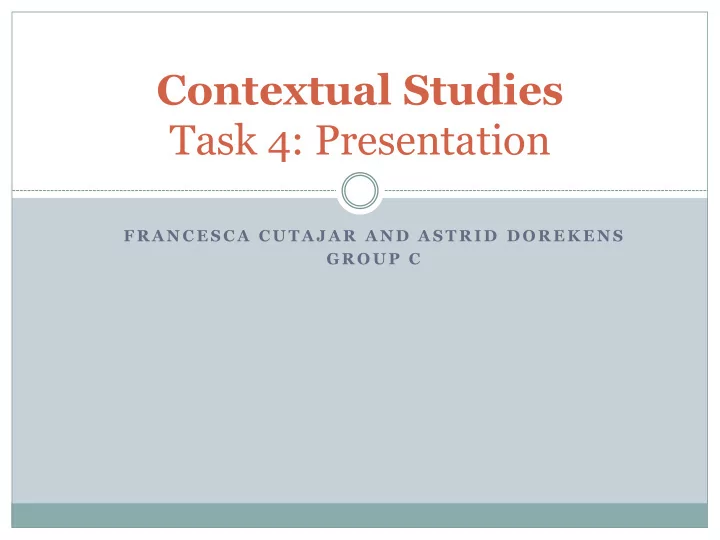

Contextual Studies Task 4: Presentation F R A N C E S C A C U T A J A R A N D A S T R I D D O R E K E N S G R O U P C
Traditional Maltese Tiles • Been locally used for about 300 years. • Number of workers who are able to produce these traditional tiles is unfortunately decreasing.
Process of Tile Making 1. They chose the mould of the shape and design they want. 2. They put something under the mould to support the mixture as it sets. 3. They put a smooth back plate, put over the mixture to weight the surface
Back in the days.. Only 2 changes were made. The mixture used to be made out of beach sand however now they use marbled powder . The pressure to produce the tiles used to be made manually now a machine is being used.
General Information about Traditional Maltese Tiles Produced individually not in batches. Durable and improves with age. Certain colours are not used because they tend to fade ex. Blue Take 10 years to polish themselves naturally therefore it is recommended to polish them often. Option of customising since they are made by order.
Inspirations Patterned buttons inspired by Maltese Tiles by Matthew Demarco Patterned mugs inspired by Maltese tiles by Stephanie Borg
Il- Girna • The ‘ Girna ’ is a hut found in the Maltese farmland. • The inside is always dome- shaped but the outside can be rectangular, round, oval or square. • Rectangular and square are more practical for sheltering more people but round or oval are more common because they are easy to build.
• Generally no windows in a 'girna ‘ • One entryway which fronts the east to increase greatest preferred standpoint from the daylight. • The stones that they use to make a ‘ girna ’ are usually found on the ground. The ones which make the field • The height may have been pathway difficult to pass. utilized as a vantage point • Sometimes in side you will for the looking over of find some stones to still, harvests, to check against some opening for air and a burglary. little rack to put farming tools.
• The majority of the bigger ‘ giren ’ were utilized for raising animals, however they have likewise been utilized for a 'house' in spite of the absence of sanitary qualities, or of even a stack for cooking. • Cooking was done in a different place, or a small stove was moved outside, bringing its fumes with it.
Buildings inspired by the ‘ Giren ’ Gozo and Maltese Farmhouses
Tberfil Tberfil is a traditional form of art which involved hand- painted lettering and is more commonly found on vintage buses, trucks and horse-drawn cabins (karrozzin). Tberfil was very popular during the 1930‘s just after the second world war ended. Bus drivers personally made sure that their bus was fully and freshly decorated with tberfil 's swirling flourishes and rich lettering styles.
The Style Usually sprayed with contrasting and bright colours such as; green, yellow and red. In my opinion it is influenced by Art Nouveau and Art Deco because of the flourish designs, line texture, colours and retro vibe.
Tberfil Influences During my research, I have also discovered that similar contemporary designs are found on the African bus located in Zimbabwe in India. The old Maltese bus and the African are quite similar since they are both so coloured with such bright tint.
Tberfil in The 21st Century Tberfil is an art that is almost dying out. But not quite. Joseph Farrugia is one of many artists that has managed to keep the traditional typography alive and keeping the Maltese culture still in contact with the public eye.
L- Għonnella The għonnella , sometimes referred to as a faldetta, was a form of women’s head dress and shawl, or hooded cloak, unique to the Mediterranean islands of Malta and Gozo. It was generally made of cotton or silk, and usually black or some other dark colour. The upper part of the għonnella was starched quite stiffly, and given a broad, rounded frame, formed by means of a board, cane, or whalebone. By a slight adjustment it could be rapped more closely to their face
Background From the twenties up to late fifties the black għonnella dominated the streets of towns and villages. From the 16th century onwards nobles would wear white or brightly coloured materials typically made of a more expensive purchase such as satin or silk whilst lower classes purchased wool. The origins of the għonnella are unknown. It has been described as a “western garment, worn in an eastern fashion.” After the fifties, it became exclusively a head cover of a laywomen’s religious organization, known as Tal -Muzew, who for decades, until the early seventies, kept the fashion alive.
The Abondoning of The Ghonnella It rapidly fell into disuse in the 1940s and 1950s, following World War II. By the 1970s, it was rarely seen at all. The abandoning of the black għonnella and the velu came about during a time when the Roman Catholic Church was undergoing changes in the accordance with the Ecumenical Council decisions which took place in the Vatican in the early sixties.
Nowadays the Għonnella ’s uni que design is portrayed through art forms such as Dingli’s artworks and is also found on vintage postcards and photographs. Postcard
Thank you
Recommend
More recommend